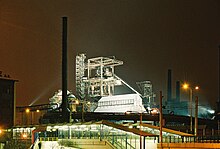Upper Silesian metropolitan area
Upper Silesian metropolitan area
Slezská Metropolitní oblast | |
|---|---|
UTC+1 (CET ) |

The Upper Silesian metropolitan area
Demographics
Upper Silesian metropolitan area has a population of 5,294,000 (2002), with 4,311,000 (81.43%) in Poland (the Upper Silesian polycentric metropolitan area) and 982,000 (18.57%) in the Czech Republic (Ostrava Functional Urban Area).[2] According to Polish Scientific Publishers (PWN) area is 5,400 km², with 4,500 km² (83.33%) in Poland and 900 km² (16.67%) in the Czech Republic.[10] According to the Brookings Institution, area has a population of 5,008,000 (2015).[1]
The area consists of several Functional Urban Areas (FUA), each of which is defined as a core Morphological Urban Area (MUA) based on population density plus the surrounding labour pool, i.e. a metropolitan area. This area contains the following FUAs:[2]
- Katowice FUA: 3,029,000; within Upper Silesian Industrial Region
- Ostrava-Cieszyn FUA: 1,046,000; within Ostrava-Karviná coal basin
- Bielsko Industrial Region
- Rybnik FUA and Racibórz FUA: 634,000 (526,000 + 109,000); within Rybnik Coal Area
Data may vary depending on the source, example for same the Katowice city exist sources for 3.5 million people;[11][12] for the Rybnik – 507,000,[7] while for the Ostrava – 1,153,876.[6]
Economy

Historically, most of the area was characterized by heavy industry since the age of industrialisation in the late 19th and early 20th century. In addition to coal, Upper Silesia also contains a number of other minable resources (methane, cadmium, lead, silver and zinc). About 70 billion tons of coal resources are available up to a depth of 1000 meters and the conditions for extraction are good.[10]
See also
References
- ^ a b "Redefining Global Cities". Brookings Institution.
- ^ ISBN 2-9600467-2-2
- ^ "Silesian". ScienceDirect.
- ^ a b Koncepcja Przestrzennego Zagospodarowania Kraju 2030
- ISBN 91-89332-38-5
- ^ a b c Eurostat, Urban Audit database Archived 2011-04-06 at the Wayback Machine, accessed on 2009-03-12. Data for 2004.
- ^ a b c (in Polish) "Społeczne i polityczne zróżnicowanie aglomeracji w Polsce" – Paweł Swianiewicz, Urszula Klimska Archived 2009-01-24 at the Wayback Machine; University of Warsaw 2005
- ^ (in Polish) Funkcje Metropolitalne Pięciu Stolic Województw Wschodnich Archived 2009-03-27 at the Wayback Machine – Tadeusz Markowski
- ^ (in Polish) "Koncepcja przestrzennego zagospodarowania kraju" Archived 2010-03-31 at the Wayback Machine – Ministry of Regional Development, 2003
- ^ a b (in Polish) "Górnośląskie Zagłębie Węglowe" – PWN Encyclopedia
- ^ www.worldatlas.com
- ^ (in Polish) "Górnośląski Okręg Przemysłowy" – PWN Encyclopedia
